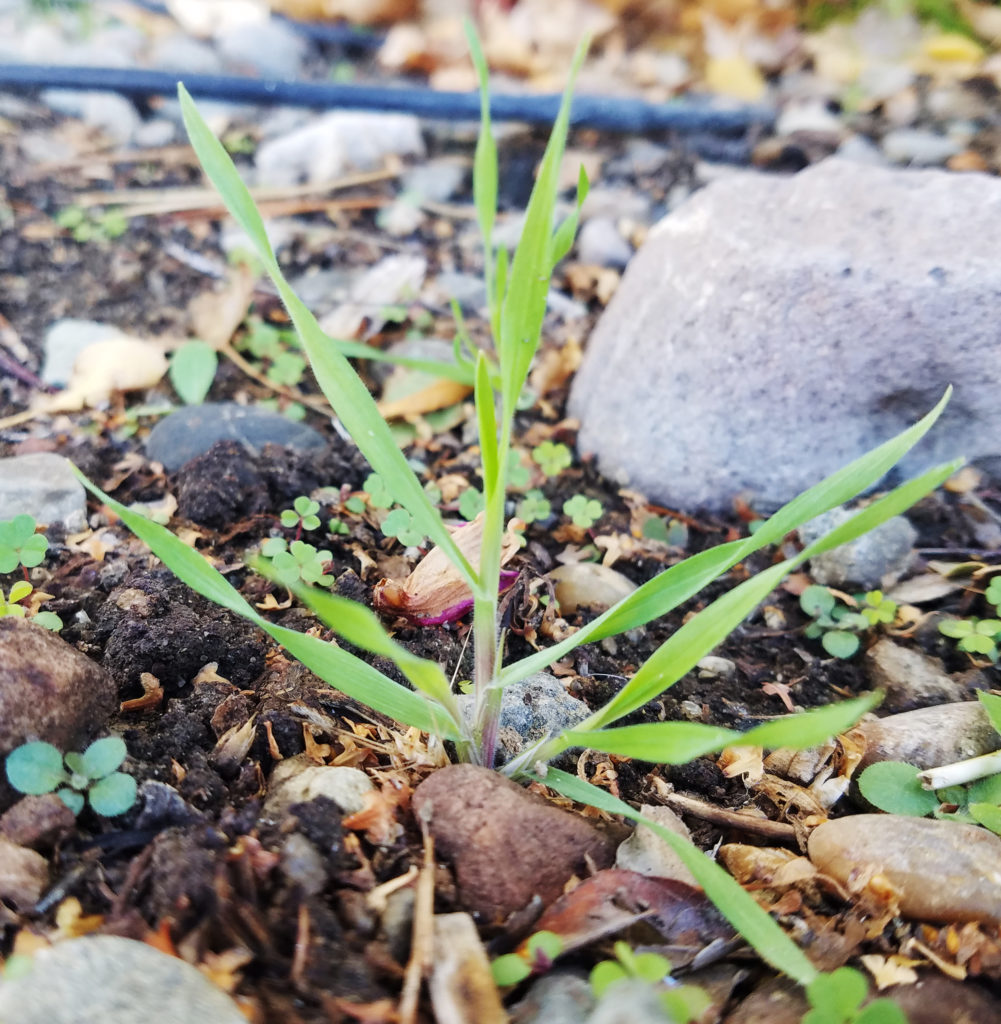Autumn Cheatgrass Management
October 24th, 2017
Cheatgrass emerging during the Fall.
A concerned resident contacted me regarding cheatgrass control because of its high-fire hazard potential. He noticed that his cheatgrass had started to germinate, but wanted to use preemergence herbicides to fight the weed. Considering that Fall is the best time to apply preemergence herbicides to control cheatgrass, I do know that it should be done before it appears. To help me better answer herbicide questions, I turned to University of Nevada Cooperative Extension’s Wendy Hanson Mazet, master gardener coordinator. I also asked Ed Smith, natural resource specialist, about cheatgrass to help answer this question.
To understand how to combat cheatgrass it’s important to understand the life cycle of this weed. Cheatgrass is a “winter annual”. That means it germinates during the fall and early winter, survives the winter, grows in the spring and dies in the summer. The seeds from the dead plant can remain in the soil up to five to seven years and the seeds will germinate under the right conditions. As Ed Smith says, “Cheatgrass goes through a green phase, a red/brown phase and finally a yellow phase. Our management goal is to prevent cheatgrass from setting seeds.” He stressed that over time, our goal is to decrease the amount of seeds present in the soil. Currently, there are some areas in Nevada that has cheatgrass already growing and other areas that haven’t seen any germination yet. The growth stage your cheatgrass is at, influences which control method is best. Here are some of the control methods for cheatgrass at different growth stages during the fall:
If cheatgrass hasn’t germinated, preemergence herbicides might be an option:
- Herbicides are chemicals that kill plants. Preemergence herbicides are chemicals that are applied before the weed appears. Some folks prefer this method because chemical application can be easier to control cheatgrass. However, there are lots of factors to consider when dealing with preemergence herbicides. According to Wendy, preemergence should be applied to bare soil and it should remain within the first one to two inches of the soil surface. If the herbicide is not within that region, it won’t work. Other factors to consider are soil type (sandy soils will have troubles retaining preemergence), slope (potential for the herbicide to migrate downhill), preemergence application (some must be watered into the soil), and where to apply herbicide (it can affect your grass and flowers or prevent your planted seeds from growing).
If cheatgrass has already sprouted, consider these options:
- Grazing Animals: If cheatgrass has already sprouted, grazing animals such as goats, sheep, cattle or even chickens can be used. Wendy cautions that grazing animals must be contained to eat the weed or they might consume other plants.
- Mechanical Methods: People can physically remove these weeds by hand pulling, hoeing, weedeating, disking or tilling, but if the soil is disturbed there is a chance for further cheatgrass or other weed growth.
- Post-emergent herbicides: Chemicals that are applied after a plant has started growing are referred to as post-emergents. Wendy warns that organic, post-emergent herbicides work best to kill broadleaf plants and not grass – so, they wouldn’t work well on cheatgrass. She recommended using either a chemical designed for both broadleaf plants and grasses, or one that only controls grasses. She added that it is important that you add a spray aid, or an adjuvant, which is a “sticker” to help the chemical adhere to the plant and to apply it before the plant sets its seed.
Herbicide application is obviously more complex than I previously thought. Every property or situation is unique with different circumstances to consider. For questions, contact Wendy Hanson Mazet at 775-784-4848 or look at these publications "Using Preemergence Herbicides for Weed Control in the Home Landscape" or “A Homeowner’s Guide to Cheatgrass”
 Jamie Roice-Gomes
Jamie Roice-Gomes
Jamie Roice-Gomes is the outreach coordinator with University of Nevada Cooperative Extension’s Living with Fire Program. She earned her Bachelor of Science in Wildlife Ecology and Conservation and a Master of Arts in Interactive Environmental Journalism. She was a public relations assistant for Conrad Communications, a public information officer intern at the Nevada Department of Conservation & Natural Resources, and a Biological Science Technician at the USDA-Agriculture Research Service. She also enjoys volleyball, the Great Basin Desert, and spending time with family. Contact Jamie at 775-336-0261 or roicej@unce.unr.edu.
